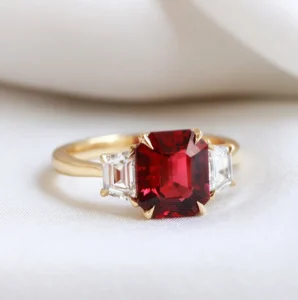Introduction
In recent years, lab grown rubies have become the game changer for gem businesses. These created stones don’t just look as beautiful; they come at a fraction of the price of real rubies. It used to be that lab-grown rubies were out of reach for the ordinary consumer, however with technology progressing quickly over recent years these have become pretty popular in most industries from fashion through of course tech.
We will take a look into lab-grown rubies from how they are made to their full potential shortly. We will also compare them to natural rubies and speak of their utility.
The Background of Man-Made Gems
- a) Synthetic rubies at an early stage of development
Synthetic rubies Date back to the 19th century. The properties of natural rubies were so intriguing to researchers and scientists that they began experimenting to figure out how we could recreate them. The invention of flame fusion by French chemist Auguste Verneuil in 1902 transformed the creation of synthetic rubies.
- b) Top Innovations Trending in Lab-Created Ruby
Ground—Up: lab grown rubies by Jennifer Heebner Smart Jewelry The first commercially viable process for lab-grown rubies was introduced in 1902 by French chemist Robert Verneuil. These have been advances that enable a greater degree of control over the chemical composition when attempting to replicate that of natural rubies with results-producing gems hard for even an untrained eye to identify as such.
Lab-Created Vs Natural Ruby
- a) Visual Differences
lab grown rubies closely resemble their natural counterparts to the naked eye. This is because lab-grown rubies are typically more flawless as they are engineered in the controlled environment of a laboratory.
- b) Chemical Composition
As for the chemical composition, lab-grown and natural rubies are also equal are aluminum oxide, but with impurities of chromium – a rare element that gives the gem its facet so highly valued in both cultures. However, in natural rubies, there may be other impurities in addition to the impurities characteristic of lab-grown crystals.
- c) Price comparison
Lab grown rubies are much cheaper than natural ones – with cost savings of up to 75%. As consumers are driven by cost factors, this makes such products popular on the market by imitating the visuals of ruby at a fraction of the cost.
Where You Find Man-Made Rubies
- a) Jewelry
For example, lab-grown rubies are popular in rings, necklaces, and earrings with their distinctive red color.
- b) Industrial Applications
The technology sector benefits hugely from lab grown rubies for their strength and precision both in watchmaking as well as laser equipment.
Are Lab-Grown Rubies Real?
- a) Authenticity
That said, lab grown rubies are indeed rubies. They have identical chemical and physical characteristics to natural rubies but are created in a laboratory.
- b) Quality Comparison with Natural Rubies
Lab-created rubies can be of equal value or even better compared to natural ones, in terms of quality because they are made under controlled conditions and hence have fewer flaws.
Rubies Grown in a Lab And Set Into Fine Jewellery
- a) Popular Styles
Lab-created rubies are commonly used in modern, sophisticated settings and have become a popular choice for engagement rings & stylish fashion jewelry.
- b) Celebrity Endorsements
A few celebrities have openly accepted the rubies grown in the laboratory which has helped them to make their way as a choice for luxury wear.
How To Recognize A Lab-Created Ruby
- a) Visual Inspection
It can be nearly impossible to visually tell the difference between a lab-grown ruby and a natural one; however, minute clarity variances are usually detectable.
- b) Professional Testing
Lab-grown rubies sometimes come with a traditional set of inclusions and therefore an experienced jeweler can easily identify their origin.
Synthetic Ruby In Technology
- a) Use in Lasers and Watches
They also are used in the production of lasers and watch movements which carry an enormous amount of energy, showcasing lab-grown rubies well beyond jewelry.
- b) Industrial Aspects and Increments
For industrial purposes, there are lab-produced rubies that have been on the market for quite some time – especially in tools as they can handle a lot more heat and pressure thanks to new technology.
A view of the lab-grown ruby market
- a) Consumer Perception
Still, as much press and hype that lab-grown rubies have received in recent years they are not entirely seen or valued by society the same way a natural ruby is. However, over time the opinion has shifted slightly as newer lab-created varieties are of a higher standard.
- b) Competitive to natural rubies
While lab grown rubies do compete with natural ones, notably in the luxury segment where rarity is favored and other than in basic jewelry for trait some would say they kind of get beaten out.
The Future of Lab-Grown Rubies
- a) Advances in Technology
The process for creating lab-grown rubies will probably be refined over time as technology advances, which means that in the future it may become possible to create even higher-quality stones.
- b) Growing Consumer Demand
The growing awareness from consumers about the negative effects of traditional mining is expected to drive up demand for lab-created rubies.
